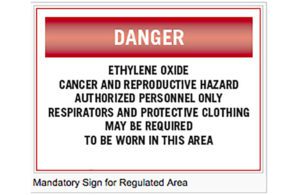
(Image from U.S. Occupational Health and Safety Administration)
The EPA now estimates that it will propose new regulations for medical device sterilizers’ emissions of ethylene oxide (EtO) in 2022.
The EPA in 2019 issued an advance notice of proposed new regulations for the cancer-causing gas used by medical device sterilizers but has yet to produce the proposal.
Now the EPA’s inspector general wants the agency to conduct a new residual risk and technology review for commercial and industrial sites that use or produce EtO, particularly because some of these facilities are located in areas populated by people of color or low income. The review would target elevated individual lifetime cancer risks affecting over 464,000 people to achieve environmental justice, according to a report released on Thursday. Studies show that breathing air containing elevated ethylene oxide levels over many years increases the risk of developing lymphoid cancers in males and females and breast cancer in females, according to an inspector general’s report.
The EPA deemed the colorless, odorless gas a human carcinogen in 2016. It is used to sterilize millions of medical devices annually and is the subject of numerous lawsuits by people living or working near medtech sterilization plants.
Fifty percent or more of the people living in the same neighborhood as 14 of 22 ethylene oxide-emitting facilities contributing to cancer risks of at least 100 in 1 million are minorities or part of low-income households, according to the agency’s environmental justice screening tool, EJSCREEN. Residents of three more neighborhoods with EtO-related facilities have an elevated cancer risk of 1,000 in 1 million or greater, the agency added. Medical device sterilizers make up 11 of these facilities, while the rest are industrial EtO sites.
If the new reviews show that people are exposed to unacceptable risk levels, the EPA should revise the National Emissions Standards for Hazardous Air Pollutants (NESHAP) for sources that emit EtO, regardless of the cost, to reduce risks to acceptable levels, the inspector general’s report said. The EPA responded that the soonest it could produce new proposed regulations for commercial sterilizers would be the fourth quarter of 2022.
Medical device companies that operate their own EtO sterilization facilities and independent EtO sterilizers have spent millions of dollars upgrading their emissions controls over the past few years.
The medical device industry relies on EtO sterilization to sterilize about 50% of all devices sold in the U.S. that require sterilization — more than 20 billion medical devices per year, according to the FDA. The gas’ properties are one reason. It works at low temperatures — between 90°F and 135°F — making it a viable option for devices made of multiple components and materials, including plastics, polymers, metals and glass, as well as coatings, bonds and packaging from damage. It can also penetrate different types of device packaging, enabling sterilizers to process truckloads’ worth of devices simultaneously.


